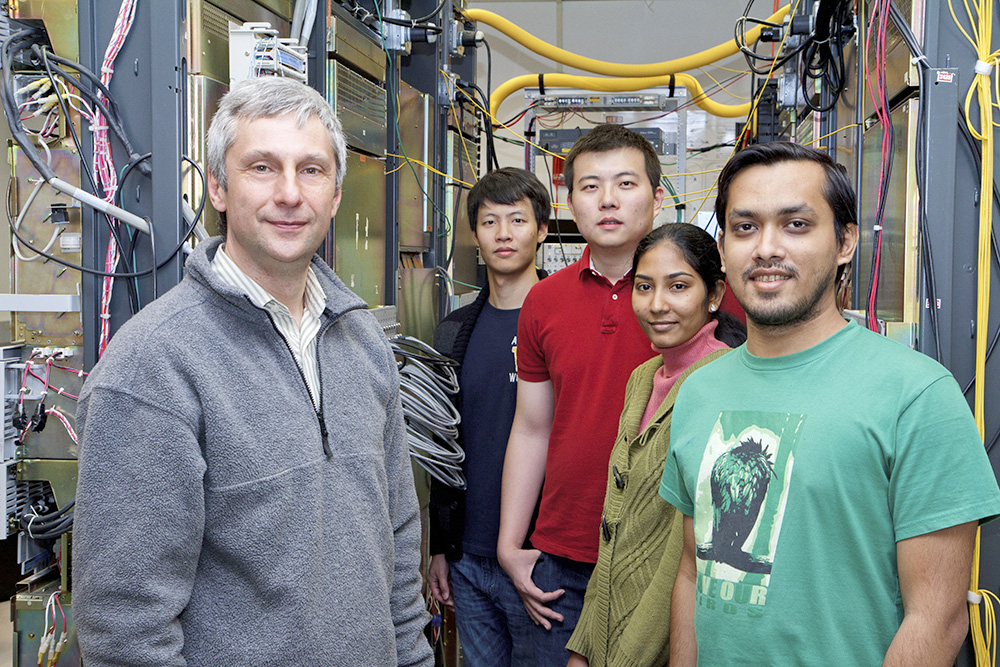
Dr. Andrea Fumagalli (left) and students stand inside his SONET (Synchronous Optical Network) optical communication system.
Dr. Andrea Fumagalli, a telecommunications expert from The University of Texas at Dallas, has been chosen to lead a subset of an international collaboration to create the computer network architecture of the future — preparing for a time when trillions of devices are expected to be connected to the Internet.
It’s expected that home electrical appliances will be controlled by smartphones in other locations, or cars will communicate with other vehicles to automatically avoid collisions. If these types of technological applications, the so-called "Internet of Things," are to become widespread, a more efficient and flexible Internet architecture needs to be created.
“We expect trillions of electronic devices connected to the Internet to be in use by 2020, each one generating tiny bits of information,” said Fumagalli, principal investigator of the ACTION (Applications Coordinate through Transport Interfaces with Optical Networks) project, funded by the National Science Foundation. “If we maintain the efficiency of today, we will need manifold amounts of equipment and capital costs to transmit and process this information.”
“JUNO brings together researchers on the leading edge of technology to create a flexible, dynamic optical highway. This endeavor is of global importance, and I look forward to working with other innovators as we create a legacy of the future.”
Dr. Andrea Fumagalli,
a telecommunications expert from The University of Texas at Dallas
Fumagalli, a professor of electrical engineering in the Erik Jonsson School of Engineering and Computer Science and director of the Open Networking Advanced Research (OpNeAR) lab, proposes the creation of dynamic optical highways in which resources can be flexibly deployed according to need. Optical highways are the medium used to transmit information at high speeds for applications such as the Internet, cable or wireless communication.
“We are no longer happy with the one-size-fits-all fixed management of the optical highway spectrum — where a predesigned Internet scheme operates for maximum capacity 24 hours a day, seven days a week, no matter the need,” he said. “If we can program devices in the network and at the edges of the network in such a way that we can go after the unused optical wavelengths or assign different capacities to different uses, this dynamic optical highway would curb the growth in equipment and costs required for expanding these networks.”
Fumagalli has prior experience creating advanced wireless and optical networks. Most recently, he co-created digital subcarrier division multiplexing flexible grid technology. This technology allows the optical highway to be sliced into smaller lanes called subcarriers that could allow more efficient data transmission.
ACTION is based at UT Dallas, with Dr. Miguel Razo, a senior lecturer in computer science, and Dr. Marco Tacca, a senior lecturer in electrical engineering, as co-principal investigators of the project. Researchers from the University of Virginia, and Japan's Keio University and the University of Electro-Communications were also involved in this research.
ACTION is one of seven subsets of the Japan-US Network Opportunity (JUNO) program.
The National Science Foundation is supporting UT Dallas with $150,000 over three years, and the Japan National Institute of Information and Communications Technology (NICT) is funding the Japanese researchers.
“JUNO brings together researchers on the leading edge of technology to create a flexible, dynamic optical highway,” Fumagalli said. “This endeavor is of global importance, and I look forward to working with other innovators as we create a legacy of the future.”